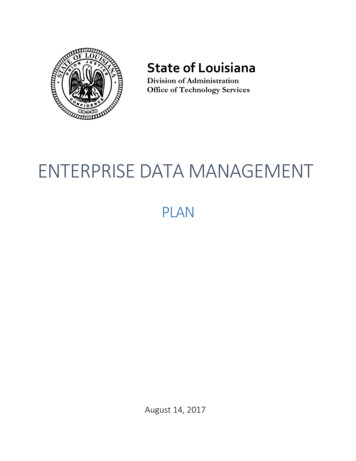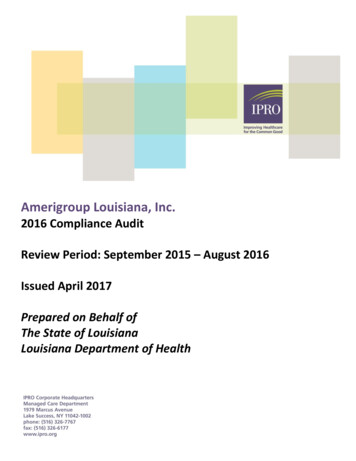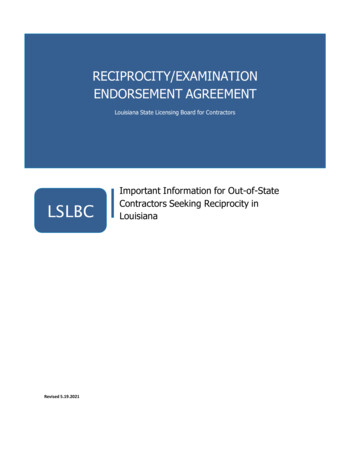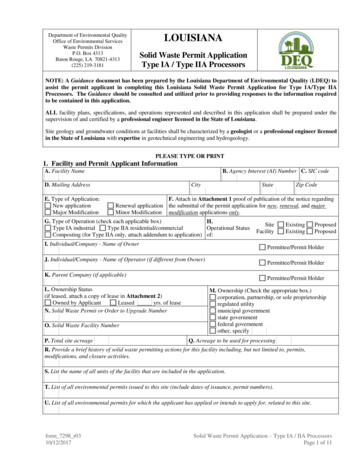
Transcription
State of LouisianaDivision of AdministrationOffice of Technology ServicesENTERPRISE DATA MANAGEMENTPLANAugust 14, 2017
Enterprise Data Management PlanOVERVIEWLouisiana’s data management strategy provides state agencies with a framework for themanagement and use of information resources. This framework is divided into twocomplementary components published as separate documents under the guidance of the DataGovernance Influence Group (DGIG). The two component documents are: Enterprise Data Management Plan *** This Document ***Enterprise Data Management Policies & StandardsEnterprise Data Management Plan is the strategic component of the data managementstrategy. Through the Plan, the overarching vision, goals, functional framework, activities, rolesand responsibilities, and evaluation metrics required to manage the State’s data assets aredefined. The Plan provides the blueprint for the enterprise data management strategy.Enterprise Data Management Policies & Standards is the tactical component of the strategy.Policies & Standards translates the conceptual ideas found in the Plan into tangible policies andstandards which become the building blocks of the enterprise data management strategy. Dataowners, stewards, custodians, and any other individuals or groups responsible for managing theState’s data, are obligated to adhere to these standards and policies.It should be noted that the Plan, although developed for the unique needs of the State ofLouisiana, is designed around the functional framework published by Data ManagementAssociation International (DAMA). The DAMA framework consists of eleven (11) functionalareas, referred to as “Knowledge Areas” in the Data Management Body of Knowledge Version 2(DMBOK2) diagram shown below (Data Management Association International, 2015, p. 18).IT GovernancePage 2 of 25
Enterprise Data Management PlanVISIONInformation is arguably the State’s most valuable asset. Without appropriate and reliable data,agencies cannot deliver the services they are mandated to provide. The public trust demandsefficient handling, effective use, and proper safeguarding of all information assets stewarded bythe State. A unified approach to information management is essential.In recognition of the great value and importance of information for the functioning ofgovernment, and to maintain a clear focus on the State’s core data management priorities, theData Governance Influence Group endorses the following vision statement:The State of Louisiana is committed to a strategy of continuous improvement in theefficiency, effectiveness, and security of its data management practices.GOALSThe Plan adopts the nine (9) data management goals identified by DAMA as common to allenterprise organizations:1. To understand the information needs of the enterprise and all its stakeholders.2. To capture, store, protect, and ensure the integrity of data assets.3. To continually improve the quality of data and information.4. To ensure privacy and confidentiality, and to prevent unauthorized or inappropriateuse of data and information.5. To maximize the effective use and value of data and information assets.6. To control the cost of data management.7. To promote a wider and deeper understanding of the value of data assets.8. To manage information consistently across the enterprise.9. To align data management efforts and technology with business needs.(Data Management Association International, 2009, p. 18)These nine data management goals in turn support achievement of two higher-level objectivesof Louisiana’s data management strategy, namely: (1) to improve the performance ofgovernment and (2) to enhance the delivery of citizen services.IT GovernancePage 3 of 25
Enterprise Data Management PlanFUNCTIONAL FRAMEWORKAs previously mentioned, the eleven “Knowledge Areas” provide the functional framework forLouisiana’s enterprise data management plan. Certain aspects of the data managementprocess – specifically: Activities, Roles and Responsibilities, and Evaluation Metrics – areidentified and mapped to each functional area as documented in this section of the Plan.The functional areas covered are: Data GovernanceData ArchitectureData Modeling & DesignData Storage & OperationsData SecurityData Integration & InteroperabilityDocuments & ContentReference & Master DataData Warehousing & Business IntelligenceMetadataData QualityThese functional areas are now presented in detail. When considered in its entirety, thissection provides the bulk of the Plan’s data management content.Data Governance –As indicated in the diagram on page 2, Data Governance is the core function of the datamanagement framework. Governance exercises authority and control over the other functionalareas.Gartner defines governance as the process of: Setting decision rights and accountability, as well as establishing policies that arealigned to business objectives;Balancing investments in accordance with policies and in support of businessobjectives;Establishing measures to monitor adherence to decisions and policies;Ensuring that processes, behaviors, and procedures are in accordance with policiesand within tolerances to support decisions.(Buytendijk & Oestreich, 2015)IT GovernancePage 4 of 25
Enterprise Data Management PlanACTIVITIESData governance activities in Louisiana include, but are not limited to, the following: Solicit input annually from State leadership on the State’s strategic direction.Establish and maintain an enterprise data governance framework in alignment withState strategic goals and objectives.Conduct business during formal, scheduled governance meetings.Identify opportunities, issues, and risks associated with data management and use.Define, review, approve, and publish statewide data management strategies,policies, and standards.Facilitate data sharing and interoperability across all state agencies.Ensure adequate security, classification, and regulatory compliance procedures arein place for sensitive data.Promote initiatives to make data accessible to everyone (internal and public) whohas a need or right to access the information.Work in cooperation with State business leaders to assess the relevancy and value ofthe State’s data assets.Initiate activities that promote the value of the State’s information assets.Solicit and receive reports from advisory committees designated to assist the DGIG.Promote data quality enhancement initiatives, especially when tangible businessbenefits can be achieved.Establish data related performance indicators.Monitor the progress of approved data management strategies, initiatives, andstandards to ensure objectives are met.Provide a forum for State staff and management to direct questions andrecommendations concerning data management, use, sharing, integration, quality,and retention.Seek input from business and technical leadership on data related budget andproject matters.Initiate activities to control the cost of managing the State’s data assets.Review statewide service offerings and projects to ensure compliance with datastandards and policies.Coordinate with other governance groups to ensure continuity on related topics.Make recommendations concerning the allocation and training of data managementresources.Receive presentations on relevant data management topics.Perform an annual review of the Data Governance Influence Group’s Charter andmakes recommendations for changes when appropriate.IT GovernancePage 5 of 25
Enterprise Data Management PlanROLES & RESPONSIBILITIESData governance roles and responsibilities are identified below Data Governance Influence Group –The Data Governance Influence Group is the guiding body responsible for statewide datagovernance in Louisiana. The Group’s influence encompasses the executive branch agencies. Itdevelops, enhances, and maintains the State’s enterprise data management strategy aspublished in the Enterprise Data Management Plan and Enterprise Data Management Policies &Standards documents. The data governance activities listed above are representative of theGroup’s responsibilities. For a full description of the DGIG and its responsibilities, reference theData Governance Influence Group Charter.Chief Information Officer –The Chief Information Officer (CIO) is the ultimate executive authority for informationtechnology and management in Louisiana. The CIO is the executive sponsor for all statewide ITgovernance groups, including the Data Governance Influence Group, and has authority to settleany outstanding disputes that arise during the governance process.Chief Data Officer –The Chief Data Officer (CDO) chairs the Data Governance Influence Group and is the chief dataasset advisor for the State of Louisiana. The CDO directs formulation of the State’s informationasset vision, strategy, plan, policies, and standards. Much of the CDO’s work is accomplishedthrough the data governance process.Advisory Committees –Advisory committees are commissioned as needed by the Data Governance Influence Group toassist the Group with research, data gathering, reporting, and recommendations. Committeemembers consist of business and technical subject matter experts (SMEs) with knowledge inareas relevant to the purpose of the committee.EVALUATION METRICSData Governance evaluation metrics are identified below Strategic & Business Objectives –Percentage of DGIG actions associated with one or more State strategic and/or businessobjectives.To determine this metric, track all actions taken by the Group. For each action, identify thespecific strategic and/or business objectives associated with the action, if any.Results Achieved –IT GovernancePage 6 of 25
Enterprise Data Management PlanPercentage of DGIG actions that achieved their desired results.To determine this metric, track all actions taken by the Group. For each action, determinewhether the original desired results were achieved, or not.Data Management Cost Savings –Dollars saved through DGIG initiated actions.To determine this metric, track cost saving results associated with actions initiated by theGroup.Data Sharing Agreements –Number of data sharing agreements.To determine this metric, track all enterprise data sharing agreements.Data Architecture –It is within the Data Architecture functional area that the foundational data needs of the Stateare assessed and architectural strategies are developed. Data architecture is a subset of thebroader statewide enterprise architecture. The focus is on mission-critical data that can beshared within the enterprise. Business need and organizational strategy drive the process.ACTIVITIESData architecture activities in Louisiana include, but are not limited to, the following: Identify the State’s requirements for mission-critical and shareable data. Organizerequirements by agency and business function.Develop, enhance, and maintain an enterprise data model. The data model mapsthe State’s information requirements with associated data specifications. Theresultant model defines data standards for the enterprise. Data modeling templatesand guidelines for use at the project-level should also be developed.Develop, enhance, and maintain an enterprise data integration model. Theintegration model defines the data flow requirements for confidential and restrictedinformation. The model must address all potential data flows internal and externalto the enterprise. Data integration templates and guidelines for use at the projectlevel should also be developed.Establish data-related hardware and software technology standards. Standards areestablished in collaboration with other state technology leaders and groups.Establish an enterprise dictionary of standard terminology for use in data-relatedbusiness and technical communications. Note that The DAMA Dictionary of DataIT GovernancePage 7 of 25
Enterprise Data Management Plan Management (Data Management Association International, 2011) has been adoptedas the official enterprise data management glossary for the State of Louisiana.Develop data architecture policies and standards for publication in Enterprise DataManagement Policies & Standards.ROLES & RESPONSIBILITIESData architecture roles and responsibilities are identified below Data Governance Influence Group –The Data Governance Influence Group reviews and approves all enterprise data architectureactivities prior to initiation. Activities are monitored and any associated results anddeliverables are presented to the Group for review and acceptance. Applicable content isdeveloped into formal policies and standards. The Group also commissions the DataArchitecture Advisory Committee.Chief Information Officer –The Chief Information Officer is the ultimate executive authority for information technologyand management in Louisiana. The CIO has final authority for the State’s enterprise dataarchitecture, including associated strategies, plans, policies, standards, and models.Chief Data Officer –The Chief Data Officer oversees data architecture activities, coordinates resources, and isresponsible for all associated results and deliverables.Chief Technology Officer –The Chief Technology Officer (CTO) directs activities related to enterprise architecture,hardware, and software standards.Chief Information Security Officer –The Chief Information Security Officer (CISO) directs activities related to enterprise security.Data Architecture Advisory Committee –The Data Architecture Advisory Committee is a select group of data experts commissioned bythe Data Governance Influence Group to develop, enhance, and maintain the enterprise dataand integration models, including templates and guidelines for project use. Working under theoversight of the Chief Data Officer, the Committee submits recommendations to the Group forconsideration and approval.EVALUATION METRICSThere are no evaluation metrics designated for Data Architecture at this time.IT GovernancePage 8 of 25
Enterprise Data Management PlanData Modeling & Design –Whereas Data Architecture deals with high-level, strategic aspects of enterprise data modeling,the Data Modeling & Design functional area dives down to address the practicalities ofgathering, analyzing, and defining business information requirements at the project or systemlevel, and then designing and implementing solutions to meet those needs.ACTIVITIESData modeling and design activities in Louisiana consist of four (4) sequential steps integral tothe system development process: Step1: Gather and analyze information requirements for pending system projects.Engage data stewards and other business subject matter experts to help capturedata requirements. Construct data models to aid the analysis process usingtemplates and guidelines approved by the Data Governance Influence Group.Step 2: Define system data and data integration requirements. Continue workingwith data stewards and business SMEs. Extend data and data integration models toinclude data definitions.Step 3: Design data structures to satisfy system information requirements. Engageapplication and data technical teams to perform the design work. Extend data anddata integration models to include design specifications.Step 4: Implement data solutions per system design specifications. Technical teamsperform implementation tasks and are joined by data stewards and business SMEsfor validation and rollout. Further extend data and data integration models tofacilitate implementation. Post-implementation, models provide excellentoperational and support documentation.ROLES & RESPONSIBILITIESData modeling and design roles and responsibilities are identified below Data Governance Influence Group –The Data Governance Influence Group approves and publishes the templates and guidelinesused for project-level data and data integration modeling.Project Manager –The project manager ensures all data management activities are scheduled, assigned, andperformed according to the project plan.Data Architect –IT GovernancePage 9 of 25
Enterprise Data Management PlanThis project-assigned individual or team is responsible for the development and maintenance ofsystem data models. An Integration Specialist may also be assigned to work on data integrationmodels.Data Stewards and Business Subject Matter Experts –These business-oriented individuals infuse essential data and business process knowledge intothe analysis, definition, and implementation phases of system development projects.Application and Data Technical Teams –These application development, data integration, and data administration teams performtechnical services in support of system development projects.EVALUATION METRICSThere are no evaluation metrics designated for Data Modeling & Design at this time.Data Storage & Operations –Data Storage & Operations encompasses the administration and operational management ofdata assets throughout their lifecycle. Accommodation must be made for the various types ofstructured and unstructured data, the technologies supporting the data, and where the data isstored, whether state-hosted (on-premises) or outsourced (cloud). As data volumes continueto grow and technological advancements progress, so too expands the scope and importance ofthis functional area.ACTIVITIESData storage and operations activities in Louisiana include, but are not limited to, the following: Plan, install, configure, and maintain environments for structured and unstructureddata. This activity presumes an understanding of business data requirements andavailable technologies.Acquire and ingest data into data storage environments.Develop, enhance, and maintain data backup and recovery plans. Plans mustaddress data loss, data corruption, and data hardware failure scenarios. Databackup and recovery plans must be incorporated into daily operational proceduresand the broader State business continuity plan.Perform backup and recovery operations in accordance with established databackup and recovery procedures.Develop and maintain data availability and performance level standards. Standardsmust meet business requirements. Monitor availability and performance levels toensure compliance. Tune data systems to optimize availability and performance.IT GovernancePage 10 of 25
Enterprise Data Management Plan Develop and maintain data retention plans. Archive and purge data in accordancewith retention plan instructions.ROLES & RESPONSIBILITIESData storage and operations roles and responsibilities are identified below Data Governance Influence Group –The Data Governance Influence Group reserves the right to review and, if necessary, revise thedata management policies, standards, and procedures pertaining to data storage andoperations.Data Custodians –Data custodians are individuals or groups responsible for the daily administration andoperational support of data and data related technologies. Data custodians are involved withall of the data storage and operations activities listed above. Perhaps the best example of adata custodian is the database administrator (DBA) position.Data Stewards –Data stewards understand data requirements from a business perspective. They provideessential input on operational matters related to data acquisition, recovery, retention, andperformance.Chief Technology Officer –The Chief Technology Officer directs activities related to enterprise architecture, hardware, andsoftware standards, including the selection of data related technologies.EVALUATION METRICSData Under Governance –Number of terabytes of mission-critical data under governance.To determine this metric, track all mission-critical datasets, including their storage sizes.Availability & Performance Standards –Number of mission-critical datasets with assigned availability and performance standards.To determine this metric, track all mission-critical datasets. Document the availability andperformance standards assigned to each dataset.Availability & Performance Compliance –Percentage of mission-critical datasets meeting their assigned availability and performancestandards.IT GovernancePage 11 of 25
Enterprise Data Management PlanTo determine this metric, track all mission-critical datasets. Monitor compliance with assignedavailability and performance standards levels.Data Security –Data Security provisions policies and procedures for the protection of data from unauthorizedaccess. Data access requires proper authentication of users and must be authorized based onbusiness need. Security also addresses the requirements for data classification, regulatorycompliance, and audit. Louisiana has a published Information Security Policy that coversrelevant topics such as: data classification and handling, encryption, physical data security,data sharing agreements, information asset management, and data sanitization.ACTIVITIESData security activities in Louisiana include, but are not limited to, the following: Assess and understand data security requirements. This assessment must considerbusiness needs, data classifications, potential threats, regulatory compliance, andthe availability of data security technologies.Develop, publish, enhance, and maintain a comprehensive information securitypolicy. Data security standards and procedures are incorporated into the policy.Implement the information security policy. Promote compliance through use ofawareness and training programs. Validate compliance through use of monitoringand audit controls.Ensure appropriate information security systems and personnel are in place withinthe enterprise. Configure systems in accordance with State and federal securitystandards and policies.ROLES & RESPONSIBILITIESData security roles and responsibilities are identified below Data Governance Influence Group –The Data Governance Influence Group reserves the right to review and, if necessary, revise thedata management policies, standards, and procedures pertaining to data security.Security Administrators –Security administrators execute properly approved security requests to grant authenticationand authorization access permissions. Security implementations can be very detailed andgranular, often involving multiple configuration points and security administrators. Forexample, a single request for database access could require the coordinated services of ActiveDirectory, server, and database administrators.IT GovernancePage 12 of 25
Enterprise Data Management PlanData Stewards –Data stewards understand data requirements from a business perspective. They provideessential input on matters related to data access and regulatory compliance.Chief Information Security Officer –The Chief Information Security Officer (CISO) directs activities related to enterprise informationsecurity, including the Information Security Policy.Information Security Team –The Information Security Team (IST) performs security enforcement and assessment activitiesunder the direction of the CISO.EVALUATION METRICSData Classification –Percentage of mission-critical datasets assigned a data classification level.To determine this metric, track all mission-critical datasets. Document the data classificationlevel assigned to each dataset.Regulatory Oversight –Percentage of mission-critical datasets subject to federal regulatory oversight.To determine this metric, track all mission-critical datasets. Document any federal regulatorycompliance requirements that may exist for each dataset.Data Integration & Interoperability –Data Integration & Interoperability focuses on the acquisition, extraction, transformation,sharing, and usage of enterprise data. This functional area is especially important as the Statestrives to better manage its data resources. The implementation of an enterprise architectureand its associated data management components will greatly facilitate opportunities for dataintegration and interoperability.ACTIVITIESData integration and interoperability activities in Louisiana include, but are not limited to, thefollowing: Assess and understand statewide data requirements. Maintain primary focus onmission-critical systems and data.IT GovernancePage 13 of 25
Enterprise Data Management Plan Inventory existing data assets. Identify all mission-critical datasets. Highlight datathat is duplicated, currently shared, or potentially shareable among multiple systemsor agencies.Identify and document external data sources.Promote data integration and interoperability opportunities when business casessupport this approach.Utilize data integration model templates and guidelines approved by the DataGovernance Influence Group when working on data integration projects. Includedata extraction and transformation steps, if applicable.Develop, enhance, and maintain data sharing agreement templates and guidelinesfor use by state agencies. Create a data sharing agreement repository. Ensureactive data sharing agreements are in place for all exchanges of confidential andrestricted data.ROLES & RESPONSIBILITIESData integration and interoperability roles and responsibilities are identified below Data Governance Influence Group –The Data Governance Influence Group approves and publishes the templates and guidelinesused by agencies for data sharing agreements and data integration modeling projects. TheGroup also commissions the Data Sharing Agreement Advisory Committee.Chief Data Officer –The Chief Data Officer oversees data integration and interoperability activities, coordinatesresources, and is responsible for all associated results and deliverables.Project Manager –The project manager ensures all data integration project activities are scheduled, assigned, andperformed according to the project plan.Data Architect and/or Integration Specialist –These project-assigned individuals are responsible for the development and maintenance ofdata integration models.Data Stewards and Business Subject Matter Experts –These business-oriented individuals provide data and business process knowledge essential tounderstanding the State’s data requirements.Application and Data Technical Teams –IT GovernancePage 14 of 25
Enterprise Data Management PlanThese application development, data integration, and data administration teams performtechnical services in support of data integration projects.Data Sharing Agreement Advisory Committee –The Data Sharing Agreement Advisory Committee is a select group of agency and legalrepresentatives commissioned by the Data Governance Influence Group to develop datasharing agreement standards, including templates, for use by state agencies. Working underthe oversight of the Chief Data Officer, the Committee submits recommendations to the Groupfor consideration and approval.EVALUATION METRICSData Sharing –Percentage of mission-critical datasets shared between at least two agencies.To determine this metric, track all mission-critical datasets. Document all data sharinginstances.Data Sharing Agreements –Percentage of shared mission-critical datasets with completed data sharing agreements.To determine this metric, track all enterprise data sharing agreements.Documents & Content –The Documents & Content functional area addresses the management of electronic andphysical documents as well as other types of unstructured content, such as email, images,faxes, audio, video, and voicemail. These “records” are grouped and organized in a logical andsystematic manner to facilitate storage, retrieval, and ongoing management.ACTIVITIESDocuments and content (records) activities in Louisiana include, but are not limited to, thefollowing: Assess and understand enterprise records management requirements. Thisassessment must consider business needs, records classification, regulatorycompliance, and retention schedules. Maintain primary focus on mission-criticalcontent.Ensure appropriate document and content management systems and personnel arein place within the enterprise. Configure systems to satisfy requirements foracquisition, storage, access, security, backup and recovery, retention, archive,disposal, and audit.IT GovernancePage 15 of 25
Enterprise Data Management Plan Confirm retention schedules are in place for all enterprise records.Develop, enhance, and maintain an enterprise index strategy for mission-criticalunstructured content. Utilize taxonomies and metadata consistent with enterprisedata architecture standards.ROLES & RESPONSIBILITIESDocuments and content roles and responsibilities are identified below Data Governance Influence Group –The Data Governance Influence Group reserves the right to review and, if necessary, revise thedata management policies, standards, and procedures pertaining to documents and content.Data Owners –Data owners are responsible for defining requirements for the data within their areas ofresponsibility, including documents and other types of unstructured content.Data Stewards and Business Subject Matter Experts –These business-oriented individuals provide data and business process knowledge essential tounderstanding the State’s records management requirements.Data Custodians –Data custodians are individuals or groups responsible for the daily administration andoperational support of data systems, including document and content management systems.Records Management Officers –Records management officers are responsible for creating, maintaining, and enforcing recordretention schedules. The records management process is governed by the Secretary of State’soffice. The Chief Data Officer serves as the records management officer for OTS.Chief Technology Officer –The Chief Technology Officer directs activities related to enterprise architecture, hardware, andsoftware standards, including the selection of data related technologies.EVALUATION METRICSUnstructured Data Indexing –Percentage of mission-critical unstructured data (documents and content) indexed to facilitateaccess and retrieval.To determine this metric, track all mission-critical unstructured data,
The Plan provides the blueprint for the enterprise data management strategy. Enterprise Data Management Policies & Standards is the tactical component of the strategy. Policies & Standards translates the conceptual ideas found in the Plan into tangible policies and standards which become the building blocks of the enterprise data management .










